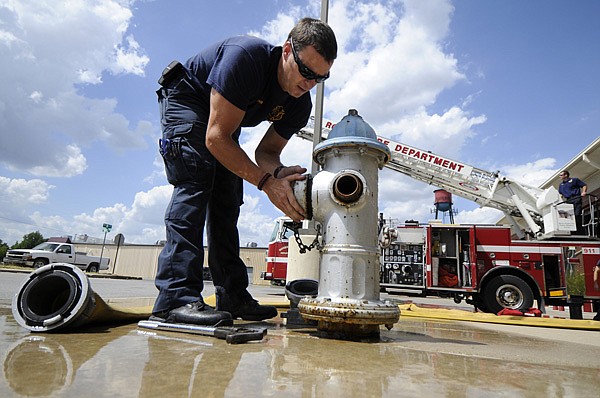Rogers Gets Four New Fire Trucks, Takes Advantage Of Technology
Rob Sampier, a Rogers firefighter and paramedic, caps a fire hydrant July 25 in front of Fire Station No. 1 following a training drill in downtown Rogers.
Saturday, August 4, 2012
ROGERS — New trucks have made the Rogers Fire Department a state-of-the-art organization when it comes to technology, said Fire Chief Tom Jenkins.
Fast Fact
Rogers Fire Department
The Fire Department was allocated $4.6 million from the 2011 bond issue to buy and equip three pumpers and a ladder truck.
Source: Staff Report
But much like football in the Southeastern Conference, depth counts almost as much as front-line units, according to the chief.
“We’re getting in three pumpers and a ladder truck,” Jenkins said. “The older trucks will go into reserve to be used during inclement weather, holidays or in a severe emergency. The professionalism and effectiveness of a fire department isn’t just determined by your front-line fleet.”
The new equipment increases the department’s reserve fleet from one truck to three pumpers and a ladder truck, Jenkins said
Control panels on the pumper trucks now look like it would take an engineer to operate it instead of just opening a fire hydrant and hooking up a hose, Jenkins said.
“It looks complicated, but the science is simple,” Jenkins said. “It’s water in and water out.”
The department has a policy of trying to replace trucks every 12 years, Jenkins said.
“We do that to try to keep up with technology and maintain our reserve fleet,” Jenkins said. “The new trucks replace 1997 models. A lot has changed since then.”
The trucks are built by a company in Minnesota to meet specifics developed for Rogers, Jenkins said.
For instance, Rogers trucks carry an introductory amount of water — 500 to 750 gallons — to get the flow started, Jenkins said.
“We carry a little more water than probably most departments because a lot of the surrounding areas we respond to are rural,” Jenkins said. “From a hydrant, we basically lay an above ground water main.”
However, when the department is fighting a fire in rural areas surrounding Rogers, the department must make its high-tech mode adapt to surroundings, according to firefighter Jonathan Nance, who started his career as a Gentry volunteer firefighter.
“The biggest deal in fighting a rural fire is finding water,” Nance said. “In the city, we have hydrants every three or four blocks. In the county, there may be a hydrant every four or five miles. We’ve had operations where we run a line into a creek to get water. We have a floating pump that strains the water and runs it right to the truck.”
At A Glance
Truck Manufacturer
Rosenbauer Minnesota manufacturers fire trucks for nearly every state and country throughout the world. Recent customers, in addition to Rogers, include Minneapolis; Bloomington, Ind.; Cleveland; Charlotte, N.C.; Fort Worth, Texas; Spokane, Wash.; China; Egypt; Israel; Korea; South Africa and the U.S. Air Force.
Source: rosenbaueramerica.com
Jenkins said, despite the complicated array of handles and gauges, the new technology on the trucks is basically used for taking water, deciding how much to use and where to put it.
“We set the (pounds per square inch) at the pump,” Jenkins said. “We’re able to generate enough pressure to knock down walls if we need to. One problem we sometimes run into is trying to put out more water than we’re taking in. That’s because the hydrant system in Rogers is excellent.
“Most everything is monitored and controlled by computer. For instance, there’s a system that, if one hose shuts down, it downgrades the flow of water to the other hoses so we don’t have a rush of pressure on the other lines.”
Tim Willette, division manager of public fire protection division with the National Fire Prevention Association, said technology monitoring water flow is an example of improvements made in firefighting.
“There was a time when the pump was a lever tied by wire to the carburetor and that controlled the flow of water,” Willette said. “It was the equivalent of pushing down on the gas pedal of the truck to get more water and letting off the gas pedal for less water. Now, that can be done with computerized pumping.”
Jenkins said, along with computers, the use of foam is also a big change.
“We’ve had it on trucks, basically in buckets, for decades,” Jenkins said. “But our new trucks have increased our foam capacity by 800 percent. It’s now in tanks. We can mix it with the water and select the strength. We can go from a mixture as light as dishwashing detergent to as thick as shaving cream.
Jenkins said the department mainly uses foam for incidents involving gasoline, diesel or any flammable liquid.
“We sometimes use foam on average house fires, too,” Jenkins said. “It helps prevent the chance of a rekindling later on, and that helps us operate more efficiently.”
Each truck takes about one year to build, Jenkins said, adding pumpers cost “about one-half million and ladder trucks about three-quarters of a million.”
Willette said technology, while expensive, not only helps fight fires, it also helps protect firefighters.
“Fire trucks have airbags, seat belts, anti-lock breaks and anti-sway systems,” Willette said. “Do these things come at a price? Yes. But in the long run, it saves money on workman’s comp and payouts in case of a catastrophic injury.”
At A Glance
Truck Manufacturer
Rosenbauer Minnesota manufacturers fire trucks for nearly every state and country throughout the world. Recent customers, in addition to Rogers, include Minneapolis; Bloomington, Ind.; Cleveland; Charlotte, N.C.; Fort Worth, Texas; Spokane, Wash.; China; Egypt; Israel; Korea; South Africa and the U.S. Air Force.
Source: rosenbaueramerica.com
